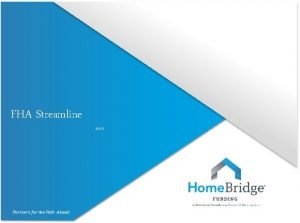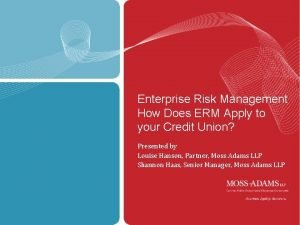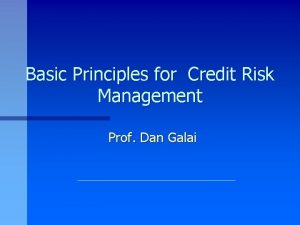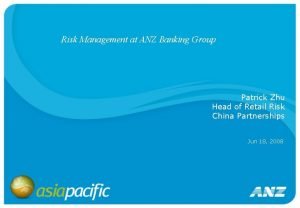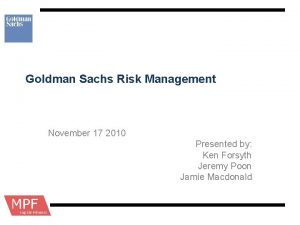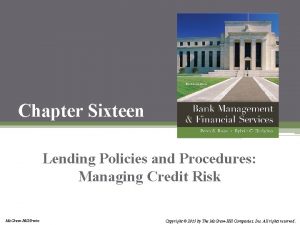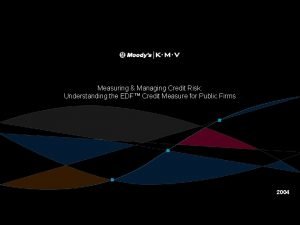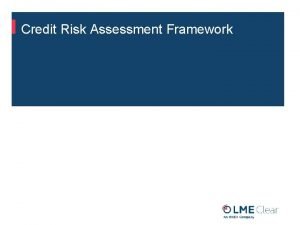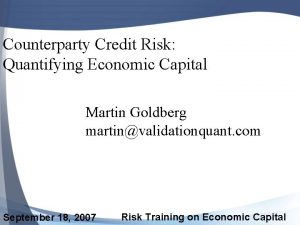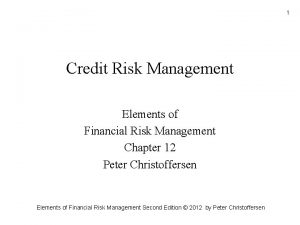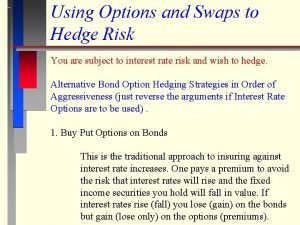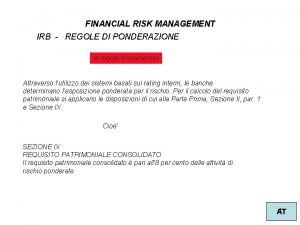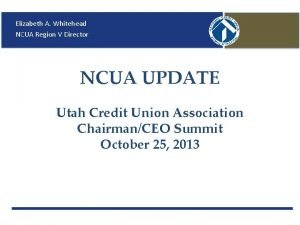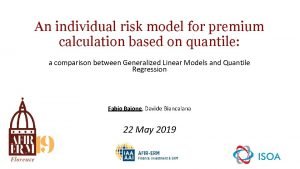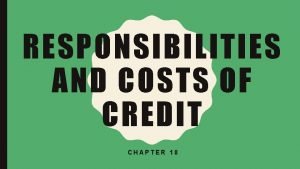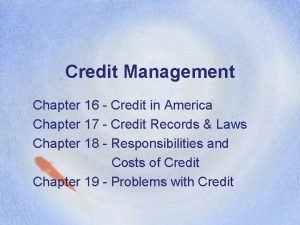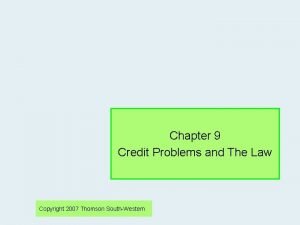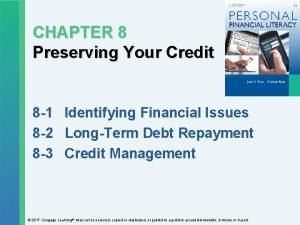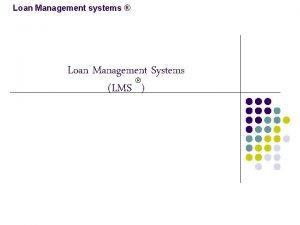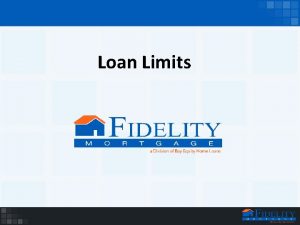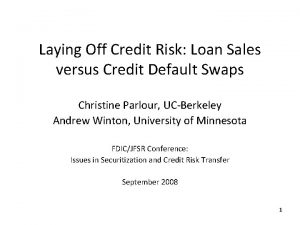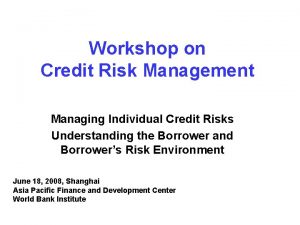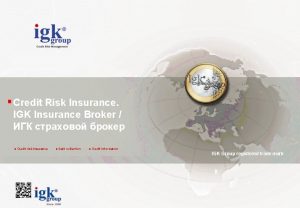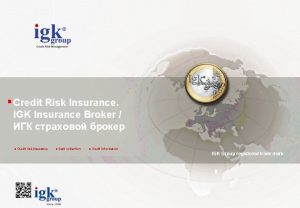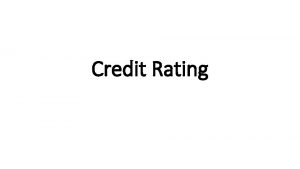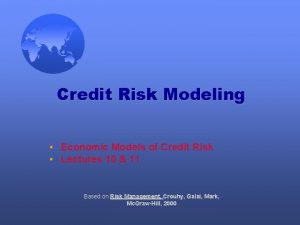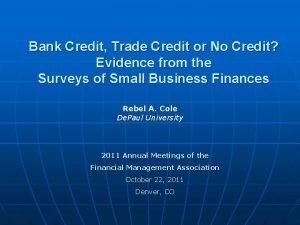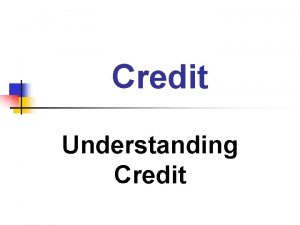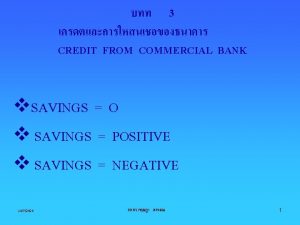Chapter 11 Credit Risk Individual Loan Risk K
























- Slides: 24

Chapter 11 Credit Risk: Individual Loan Risk K. R. Stanton © 2006 The Mc. Graw-Hill Companies, Inc. , All Rights Reserved.

Overview 11 -2 u This chapter discusses types of loans, and the analysis and measurement of credit risk on individual loans. This is important for purposes of: l l Pricing loans and bonds Setting limits on credit risk exposure Mc. Graw-Hill/Irwin © 2006 The Mc. Graw-Hill Companies, Inc. , All Rights Reserved.

Credit Quality Problems 11 -3 u Problems with junk bonds, LDC loans, residential and farm mortgage loans. u More recently, credit card and auto loans. u Crises in Asian countries such as Korea, Indonesia, Thailand, and Malaysia. u Default of one major borrower can have significant impact on value and reputation of many FIs u Emphasizes importance of managing credit risk Mc. Graw-Hill/Irwin © 2006 The Mc. Graw-Hill Companies, Inc. , All Rights Reserved.

Web Resources 11 -4 u For further information on credit ratings visit: Moody’s www. moodys. com Standard & Poors www. standardandpoors. com Mc. Graw-Hill/Irwin © 2006 The Mc. Graw-Hill Companies, Inc. , All Rights Reserved.

Credit Quality Problems u u u 11 -5 Over the early to mid 1990 s, improvements in NPLs for large banks and overall credit quality. Late 1990 s concern over growth in low quality auto loans and credit cards, decline in quality of lending standards. Exposure to Enron. Late 1990 s and early 2000 s: telecom companies, tech companies, Argentina, Brazil, Russia, South Korea New types of credit risk related to loan guarantees and off-balance-sheet activities. Increased emphasis on credit risk evaluation. Mc. Graw-Hill/Irwin © 2006 The Mc. Graw-Hill Companies, Inc. , All Rights Reserved.

Types of Loans: u C&I l l loans: secured and unsecured Syndication Spot loans, Loan commitments Decline in C&I loans originated by commercial banks and growth in commercial paper market. Downgrades of Ford, General Motors and Tyco u RE l 11 -6 loans: primarily mortgages Fixed-rate, ARM Mortgages can be subject to default risk when loan-to-value declines. Mc. Graw-Hill/Irwin © 2006 The Mc. Graw-Hill Companies, Inc. , All Rights Reserved.

Consumer loans 11 -7 u Individual (consumer) loans: personal, auto, credit card. l Nonrevolving loans § l Growth in credit card debt § § l Automobile, mobile home, personal loans Visa, Master. Card Proprietary cards such as Sears, AT&T Risks affected by competitive conditions and usury ceilings Mc. Graw-Hill/Irwin © 2006 The Mc. Graw-Hill Companies, Inc. , All Rights Reserved.

Other loans u Other l l l 11 -8 loans include: Farm loans Other banks Nonbank FIs Broker margin loans Foreign banks and sovereign governments State and local governments Mc. Graw-Hill/Irwin © 2006 The Mc. Graw-Hill Companies, Inc. , All Rights Reserved.

Return on a Loan: 11 -9 u Factors: interest payments, fees, credit risk premium, collateral, other requirements such as compensating balances and reserve requirements. u Return = inflow/outflow k = (f + (L + M ))/(1 -[b(1 -R)]) u Expected return: E(r) = p(1+k)-1 where p equals probability of repayment u Note that realized and expected return may not be equal. Mc. Graw-Hill/Irwin © 2006 The Mc. Graw-Hill Companies, Inc. , All Rights Reserved.

Lending Rates and Rationing 11 -10 u At retail: Usually a simple accept/reject decision rather than adjustments to the rate. l l l u At l Credit rationing. If accepted, customers sorted by loan quantity. For mortgages, discrimination via loan to value rather than adjusting rates wholesale: Use both quantity and pricing adjustments. Mc. Graw-Hill/Irwin © 2006 The Mc. Graw-Hill Companies, Inc. , All Rights Reserved.

Measuring Credit Risk 11 -11 u Availability, quality and cost of information are critical factors in credit risk assessment l Facilitated by technology and information u Qualitative models: borrower specific factors are considered as well as market or systematic factors. u Specific factors include: reputation, leverage, volatility of earnings, covenants and collateral. u Market specific factors include: business cycle and interest rate levels. Mc. Graw-Hill/Irwin © 2006 The Mc. Graw-Hill Companies, Inc. , All Rights Reserved.

Credit Scoring Models u Linear 11 -12 probability models: Zi = l l Statistically unsound since the Z’s obtained are not probabilities at all. *Since superior statistical techniques are readily available, little justification for employing linear probability models. Mc. Graw-Hill/Irwin © 2006 The Mc. Graw-Hill Companies, Inc. , All Rights Reserved.

Other Credit Scoring Models 11 -13 u Logit models: overcome weakness of the linear probability models using a transformation (logistic function) that restricts the probabilities to the zero-one interval. u Other alternatives include Probit and other variants with nonlinear indicator functions. u Quality of credit scoring models has improved providing positive impact on controlling write-offs and default Mc. Graw-Hill/Irwin © 2006 The Mc. Graw-Hill Companies, Inc. , All Rights Reserved.

Altman’s Linear Discriminant Model: u Z=1. 2 X 1+ 11 -14 1. 4 X 2 +3. 3 X 3 + 0. 6 X 4 + 1. 0 X 5 Critical value of Z = 1. 81. l X 1 = Working capital/total assets. l X 2 = Retained earnings/total assets. l X 3 = EBIT/total assets. l X 4 = Market value equity/ book value LT debt. l X 5 = Sales/total assets. Mc. Graw-Hill/Irwin © 2006 The Mc. Graw-Hill Companies, Inc. , All Rights Reserved.

Linear Discriminant Model 11 -15 u Problems: l l Only considers two extreme cases (default/no default). Weights need not be stationary over time. Ignores hard to quantify factors including business cycle effects. Database of defaulted loans is not available to benchmark the model. Mc. Graw-Hill/Irwin © 2006 The Mc. Graw-Hill Companies, Inc. , All Rights Reserved.

Term Structure Based Methods l l l 11 -16 If we know the risk premium we can infer the probability of default. Expected return equals risk free rate after accounting for probability of default. p (1+ k) = 1+ i May be generalized to loans with any maturity or to adjust for varying default recovery rates. The loan can be assessed using the inferred probabilities from comparable quality bonds. Mc. Graw-Hill/Irwin © 2006 The Mc. Graw-Hill Companies, Inc. , All Rights Reserved.

Mortality Rate Models l l 11 -17 Similar to the process employed by insurance companies to price policies. The probability of default is estimated from past data on defaults. Marginal Mortality Rates: MMR 1 = (Value Grade B default in year 1) (Value Grade B outstanding yr. 1) MMR 2 = (Value Grade B default in year 2) (Value Grade B outstanding yr. 2) l Many of the problems associated with credit scoring models such as sensitivity to the period chosen to calculate the MMRs Mc. Graw-Hill/Irwin © 2006 The Mc. Graw-Hill Companies, Inc. , All Rights Reserved.

RAROC Models l l 11 -18 Risk adjusted return on capital. This is one of the more widely used models. Incorporates duration approach to estimate worst case loss in value of the loan: DLN = -DLN x (DR/(1+R)) where DR is an estimate of the worst change in credit risk premiums for the loan class over the past year. RAROC = one-year income on loan/DLN Mc. Graw-Hill/Irwin © 2006 The Mc. Graw-Hill Companies, Inc. , All Rights Reserved.

Option Models: l l l 11 -19 Employ option pricing methods to evaluate the option to default. Used by many of the largest banks to monitor credit risk. KMV Corporation markets this model quite widely. Mc. Graw-Hill/Irwin © 2006 The Mc. Graw-Hill Companies, Inc. , All Rights Reserved.

Applying Option Valuation Model 11 -20 u Merton showed value of a risky loan F(t) = Be-it[(1/d)N(h 1) +N(h 2)] u Written as a yield spread k(t) - i = (-1/t)ln[N(h 2) +(1/d)N(h 1)] where k(t) = Required yield on risky debt ln = Natural logarithm i = Risk-free rate on debt of equivalent maturity. t = remaining time to maturity Mc. Graw-Hill/Irwin © 2006 The Mc. Graw-Hill Companies, Inc. , All Rights Reserved.

*Credit. Metrics 11 -21 u “If next year is a bad year, how much will I lose on my loans and loan portfolio? ” VAR = P × 1. 65 × s u Neither P, nor s observed. Calculated using: l (i)Data on borrower’s credit rating; (ii) Rating transition matrix; (iii) Recovery rates on defaulted loans; (iv) Yield spreads. Mc. Graw-Hill/Irwin © 2006 The Mc. Graw-Hill Companies, Inc. , All Rights Reserved.

* Credit Risk+ u Developed 11 -22 by Credit Suisse Financial Products. l Based on insurance literature: § l l Losses reflect frequency of event and severity of loss. Loan default is random. Loan default probabilities are independent. u Appropriate for large portfolios of small loans. u Modeled by a Poisson distribution. Mc. Graw-Hill/Irwin © 2006 The Mc. Graw-Hill Companies, Inc. , All Rights Reserved.

Pertinent Websites 11 -23 Federal Reserve Bank www. federalreserve. gov OCC www. occ. treas. gov KMV www. kmv. com Card Source One www. cardsourceone. com FDIC www. fdic. gov Robert Morris Assoc. www. rmahq. org Mc. Graw-Hill/Irwin © 2006 The Mc. Graw-Hill Companies, Inc. , All Rights Reserved.

Pertinent Websites 11 -24 Fed. Reserve Bank St. Louis www. stls. frb. org Federal Housing Finance Board www. fhfb. gov Moody’s www. moodys. com Standard & Poors www. standardandpoors. com Mc. Graw-Hill/Irwin © 2006 The Mc. Graw-Hill Companies, Inc. , All Rights Reserved.
 Liquidity measures
Liquidity measures Fha connection
Fha connection This can be avoided by giving credit where credit is due.
This can be avoided by giving credit where credit is due. Inherent risks examples
Inherent risks examples Hedge fund credit risk
Hedge fund credit risk Credit risk types
Credit risk types Anz credit risk
Anz credit risk Credit risk management and advisory goldman sachs
Credit risk management and advisory goldman sachs Lending policies and procedures managing credit risk
Lending policies and procedures managing credit risk Credit risk in international trade
Credit risk in international trade Measuring and managing credit risk
Measuring and managing credit risk Credit risk management framework
Credit risk management framework Martin goldberg economic invincibility
Martin goldberg economic invincibility Elements of financial risk management
Elements of financial risk management Hedging credit risk with options
Hedging credit risk with options Crm credit risk management
Crm credit risk management Ncua aires questionnaire
Ncua aires questionnaire Individual risk model
Individual risk model Chapter 18 responsibilities and costs of credit
Chapter 18 responsibilities and costs of credit Vertical name
Vertical name Property pledged to assure repayment of a loan
Property pledged to assure repayment of a loan Chapter 9 obtaining and protecting your credit
Chapter 9 obtaining and protecting your credit Chapter 9 credit problems and laws
Chapter 9 credit problems and laws Chapter 8 preserving your credit
Chapter 8 preserving your credit Preserving your credit
Preserving your credit

